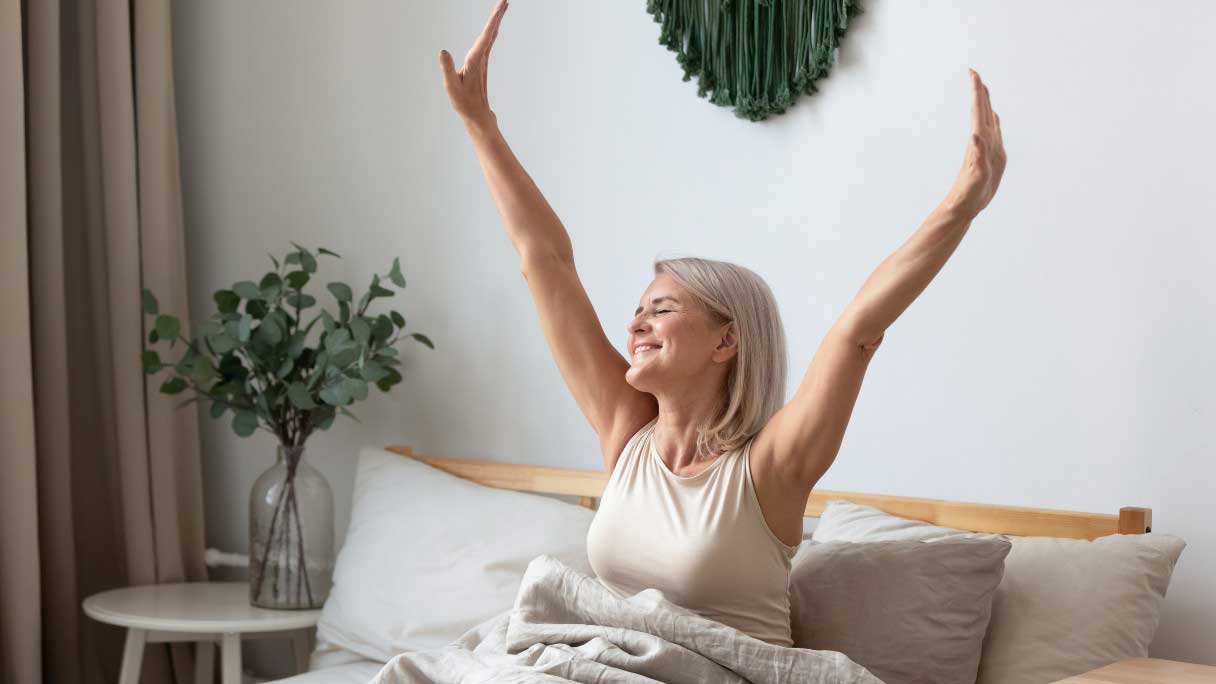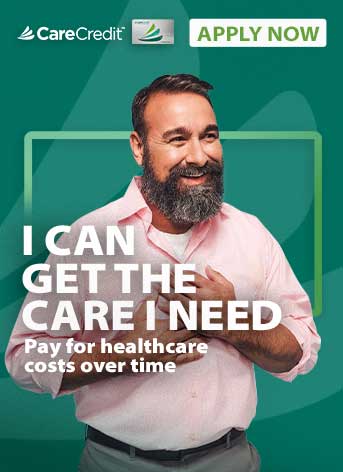It’s the middle of the night, and you’re staring at your ceiling, willing sleep to come. Instead, it seems like the harder you try, the more awake you feel. You ask yourself, should I just get out of bed? Drink warm milk? Take a sleeping aid?
We all experience sleepless nights from time to time. But if you regularly wake up tired or are unable to fall or stay asleep, it may be time to talk to your doctor about a sleep study.
What Is a Sleep Study?
A sleep study (polysomnogram) is an overnight examination during which doctors track and measure your sleep cycle to help determine if you have a sleeping disorder. Sleep studies can be completed either in person or at home. In-person sleep studies may take place in a hospital or freestanding sleep center. These settings are outfitted to be as close to a home sleeping environment as possible. At-home sleep studies are completed in your own sleeping environment, minimizing disruption to your normal sleep routine.1
Common sleeping disorders diagnosable with a sleep study include:
- Circadian rhythm disorders. This is a condition where your body’s natural 24-hour clock does not align with the typical day/night sleep-wake cycle.2
- Insomnia. With this condition, you may not be able to fall asleep or stay asleep. Insomnia may be acute (short-term) or chronic (long-term).3
- Narcolepsy or hypersomnolence (excessive sleepiness). This is a condition where you fall asleep suddenly and randomly during the day, disrupting your nighttime sleep.4
- Parasomnias and abnormal sleep behaviors. These conditions may include walking, talking, eating, urinating or initiating sexual activity while asleep, occurring during non-rapid eye movement (NREM) sleep. In addition, you can experience nightmares and sleep paralysis (unable to move when waking up) during the rapid eye movement (REM), or dream, sleep stage.5
- Restless leg syndrome (RLS) and periodic limb movement disorder (PLMD). These conditions include moving your arms and legs (limbs) frequently during sleep or having the constant urge to move them when awake. These may lead to insomnia or daytime sleepiness.6
- Sleep apnea or other sleep-related breathing disorders. This occurs when your breathing suddenly stops while you sleep. Daytime sleepiness is the most common sign of sleep apnea. If the disorder is left untreated, you can develop complications, including high blood pressure, heart attack or stroke.7
How Much Does a Sleep Study Cost?
The cost of a sleep study can range between $500 and $3,000, while an at-home test typically costs between $300 and $600.8
The cost of your sleep study will depend on a few things, including whether your test is at a lab or at home and whether or not insurance will cover it.8
Does Insurance Cover a Sleep Study?
Medicare and most health insurance plans may include coverage for sleep studies and may cover most of the cost if you meet the criteria defined by your insurance plan.8 So be sure to check with your plan provider to determine your specific benefits.
The amount of coverage and out-of-pocket costs you will pay depends on many factors, including:8
- Your private medical insurance plan and provider
- Annual deductible
- Copay requirements
- In-network vs. out-of-network provider
How Does a Sleep Study Work?
During a sleep study, your doctor gathers important information to provide a comprehensive overview of the quality of your sleep. Ultimately, sleep studies provide essential details that help your doctor decide if you need treatment for a sleep disorder, and if so, what the best options might be to (finally!) ensure a good night’s sleep.1
How a sleep study works depends on whether you’re having an in-person study or an at-home study.
At-home sleep study
At-home sleep studies are typically used to diagnose sleep apnea rather than other disorders that may require more extensive sleep tracking like monitoring brain waves or breathing and movement.9 They generally take at least two nights but can be less.
Your doctor can help you decide if an at-home sleep study is the right approach for you based on your symptoms. You will likely be mailed a kit with instructions if you opt for an at-home sleep apnea test.
More advanced home sleep studies, including those for narcolepsy and restless leg syndrome as well as sleep apnea, require you to visit the sleep center and have sensors placed to measure brain waves during your sleep study.10
The home sleep apnea test (HSAT) typically uses sensors to measure blood oxygen levels, heart rate and breathing.9 When you opt for the HSAT, your sensors, equipment and instructions may be mailed to you, or you may need to visit the sleep center. If you receive the kit by mail, it will come with detailed instructions on how to place the sensors and connect them to the monitoring equipment.
After the study, you will either return the kit by mail or take it to your sleep center. Using the HSAT allows you to complete sleep testing in your normal sleep environment. If your doctor has some concerns about the results of your sleep test, they may follow it with an in-person sleep study.9
In-person sleep study
In-person sleep studies typically only take one night. Before an in-person sleep study, you’ll work with your doctor to find a specialist at a sleep center or lab. Once you’re at the sleep center, you’ll check in (much like when you visit your doctor), and the team of sleep specialists will help make you comfortable before the study begins.
To measure what your body does while sleeping, the sleep center team will place sensors on areas like your head, face, chest and legs. This will allow them to record, monitor and measure:11
- Brain wave activity
- Breathing pattern
- Blood oxygen levels
- Body position
- Eye movements
- Heart rate
- Leg movements
- Snoring and other noises you may make as you sleep
Once all of the sensors have been placed, they will be connected to the monitoring equipment located inside the sleep suite. This equipment transmits data to the sleep center team located in an adjacent area, and they record the information for review by the sleep specialist. You will be asleep during most of the study — the point, after all, is to see what’s happening when you’re sleeping.
Preparing for Your Sleep Study
To prepare for your sleep study, you should take all of your usual medications on the night of your sleep study. For at-home studies, you should follow your normal sleep routine. If you drink alcohol, it is recommended that you not alter your alcohol intake for the sleep study, as it can impact the accuracy of the test.11
If you are doing an in-person sleep study, make sure you have someone to drive you to the sleep center if you have had any alcohol to drink. While caffeine intake may impact the sleep study, it is important to maintain your habits to get the best results possible from your sleep study. Be sure to let the sleep center team know about any alcohol or caffeine intake you had on the day of the study.11
Bring any toiletries that you use during your nightly routine to maintain consistency. In addition, you should bring your usual sleep clothing to maximize your comfort. If you read or have any other routine activity before bed, such as yoga, bring what you need for these activities with you as well.
Sleep is critical to our overall health and well-being. Sleep disorders can lead to serious health issues, including high blood pressure, heart attack or stroke. If you have difficulty falling or staying asleep or are excessively sleepy during the day, it may be time to talk to your doctor about getting a sleep study.
Frequently Asked Questions About Sleep Studies
Do you still have questions about sleep studies? Here are answers to some frequently asked questions.
Managing Health and Wellness Costs With the CareCredit Credit Card
If you are looking for an option to help manage your health and wellness costs, consider financing with the CareCredit credit card. The CareCredit credit card can help you pay for the care you want and need and make payments easy to manage.* Use our Acceptance Locator to find a provider near you that accepts CareCredit. Continue your wellness journey by downloading the CareCredit Mobile App to manage your account, find a provider on the go and easily access the Well U blog for more great articles, podcasts and videos.
Your CareCredit credit card can be used in so many ways within the CareCredit network including vision, dentistry, cosmetic, pet care, hearing, health systems, dermatology, pharmacy purchases and spa treatments. How will you invest in your health and wellness next?
Author Bio
Steve Marshall, D.N.P., M.S.N., B.S.N, R.N., has over 30 years of nursing experience, with diverse expertise in clinical leadership, ER, oncology, infectious disease and more. Using his clinical knowledge, he has written for top publications including Everyday Health, the National Council on Aging and Next Avenue. He is dedicated to combining his extensive nursing knowledge with well-crafted storytelling to help those seeking factual medical information.








